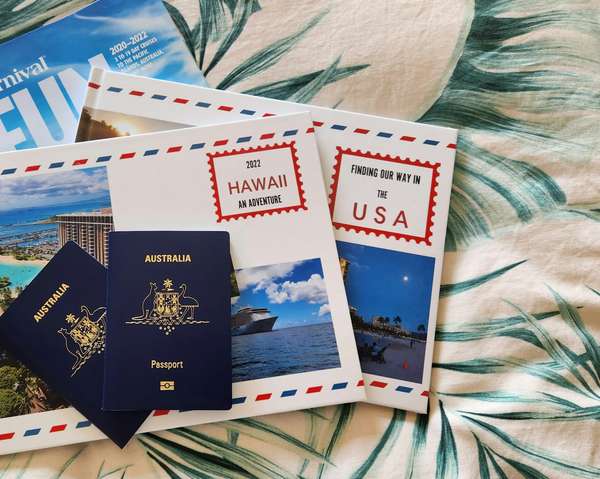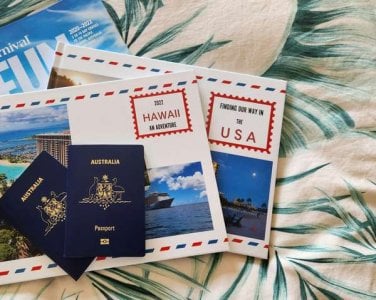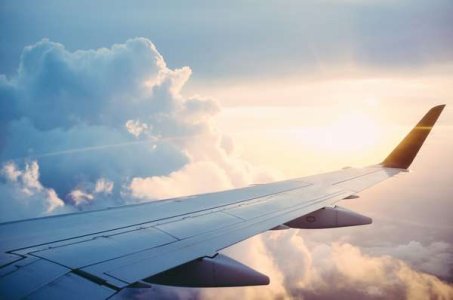

An Australian shared his disbelief after he was stopped from flying into the United States after customs officials falsely accused him of illegally living there for 14 years.
Aaron Drooger's dream Las Vegas getaway turned into a bureaucratic nightmare when US officials accused him of something impossible — illegally living in America for more than a decade.
The Lismore man had visited Hawaii once in 2011, dutifully returned home to NSW, yet somehow the US immigration system believed he'd never left.
In April this year, he took a cruise ship to Vancouver, Canada, and attempted to then fly from Vancouver into the States. He was stopped from boarding his flight to Las Vegas at the airport, meaning he had to change his travel plans and book a direct flight to Brisbane.
Immigration officers told Mr Drooger he had been staying illegally in the US for over a decade — a phantom overstay that would cost him thousands and derail his holiday plans. The system even claimed he had been in the US for 4,000 days.
The system that forgot departures
The heart of the problem lies in how the US tracks who comes and goes. Until recently, the system relied heavily on physical I-94 departure cards and various data sources, including flight manifests, which can occasionally fail. When these systems don't properly record a departure, travellers can appear to have ‘overstayed’ even when they left years ago.
Mr Drooger had visited Hawaii on an Electronic System for Travel Authorisation (ESTA) and believes his departure wasn't correctly logged.
As a result, the system showed him as an ‘in-country overstay’ — someone for whom there was no departure record and who therefore appeared to have exceeded their authorised stay.
Immigration lawyer and former US visa officer Christa Byker explains the automated nature of the problem: ‘If the system finds even a minor issue, you may be denied’ and ‘If there's anything even slightly confusing in your profile, the automated system will likely reject it.’
'All of these errors forced me to spend thousands of dollars extra and ruined my holiday.'
Despite having the appropriate evidence to prove he never overstayed his ESTA, Mr Drooger has yet to receive answers from US immigration.
Not an isolated incident
Several Aussies claim they have faced similar issues. Queensland couple Phil and Julie Lawton left the US on May 21 this year. Weeks after they touched back down in Brisbane, they were bombarded with emails from US immigration officers.
'On the 10th of July, we got the first notice that we've got 19 days to leave the country,' Ms Lawton said. She added that the emails were nearly filed as junk.
The couple were made to jump through numerous hoops to try to convince officials they had actually left the US. They also contacted Home Affairs in Australia to try to confirm their record of return, but as yet, they have been unsuccessful.
Both Mr and Ms Lawton have been to the States about ten times, but doubt they will be able to go back. 'I have no confidence, and I don't think Julie has either, that unless we actually got written confirmation from US Border Protection they have made a mistake and we did leave the US on the 21st (of May), we could ever return to the US,' Mr Lawton said. The pair are still receiving regular communications warning them about their supposed visa breach.
When Americans aren't tracking accurately
Immigration enforcement statistics reveal the scope of false leads: officials reviewed thousands of potential overstay cases but 'did not always validate the veracity of actionable leads. As a result, viable staff time was wasted chasing down false leads.'
The Department of Homeland Security acknowledges its tracking limitations, admitting 'its systems have difficulty identifying students who do not depart via air or who change status.'
While this specific reference relates to student visas, the principle applies more broadly — the US immigration system struggles with comprehensive departure tracking.
How departure tracking failures happen
The US immigration system relies on multiple data sources to track entries and exits:
• Flight manifests from airlines
• Physical I-94 forms (now mostly electronic)
• Border crossing records
• Customs and immigration databases
When these systems don't communicate properly or data gets lost, travellers can appear to have never left, even years later.
Historical context reveals this isn't new: 'In 1995 collection of I-94s was rather lax especially on US/Canada border given that you could travel between the countries with just your driver's licence.' While systems have improved, gaps remain.
The appeals process: DHS TRIP
For Australians caught in these system errors, there is an official avenue for redress. The Department of Homeland Security Traveler Redress Inquiry Program (DHS TRIP) serves as 'a single point of contact for individuals who commonly face difficulties during travel screenings' including those 'denied or delayed entry into the United States.'
DHS TRIP specifically covers cases involving 'amending a traveler record because of an overstay as a result of not submitting the required Form I-94 when exiting the United States.' This directly addresses situations like Mr Drooger's.
Legal experts recommend the program: 'The DHS TRIP program is meant to help travelers address situations like this. You should obtain whatever evidence you can obtain that you did not overstay and prepare to submit it with this program.'
Limited Australian government intervention
While Australian consular services can provide support, their ability to intervene in US immigration decisions is restricted. The Consular Services Charter clearly states: 'While the Australian Government will do what it can to help you, there are circumstances in which our ability to provide assistance will be limited.'
For detention or legal issues, 'We can't get you out of prison/detention or provide legal advice, but we can provide you with a range of information including contact details for local lawyers. We will do what we can to ensure you are treated in accordance with local law and process.'
Australian travellers facing these issues can contact their nearest consulate, but the resolution typically requires working through US systems like DHS TRIP or engaging immigration lawyers familiar with American processes.
Travel insurance and ESTA risks
Travel insurers will rarely reimburse travellers for such problems, as they see the errors as avoidable visa issues.
An immigration lawyer said the ESTA issue can affect non-citizens who try to re-enter the US. Sherwin Noorian explained that the various data sources which supply the system, including flight manifests, can occasionally fail, resulting in an 'overstay' being recorded against the traveller in question.
New complications on the horizon
Recent US policy changes may affect Australian travellers. Starting in August 2025, the US has implemented a visa bond pilot program targeting 'nationals of countries identified by the Department as having high visa overstay rates' with bonds 'up to $15,000 as a condition of visa issuance.'
What this means for you
- The program primarily targets countries with high overstay rates and does not include Australia, Canada, Mexico, or Visa Waiver Program countries
- If you are falsely flagged as an overstay, it could still complicate future US travel applications
- Being flagged may subject you to additional scrutiny and delays
Conversely, there's positive news for frequent Australian travellers. After years of delays, 'the first stage of US Global Entry is finally here for Australians. Initially, applications are open to frequent US visitors, and will expand to all Australian citizens later in 2025.'
Expert advice for protection
Protecting yourself from system errors
- Keep all travel documents, boarding passes, and entry/exit stamps
- Take photos of passport stamps upon departure
- Save electronic receipts showing departure from the US
- Apply for ESTA well in advance (at least 72 hours before travel)
- Consider Global Entry if you're a frequent US traveller
- Keep records of accommodation, activities, and expenses during your stay
Legal experts emphasise prevention: 'An immigration lawyer can discuss with you the steps required to remain in the U.S. legally, and if you have overstayed your visa, the alternatives you may consider. You are most likely to experience the best possible outcome if you consult with an experienced immigration lawyer before your visa expires.'
The technology challenge
Former visa officer Christa Byker warns that even strong passports don't guarantee smooth processing: 'We've seen travellers with strong passports like Australia's still get denied because of hidden red flags or inconsistencies. The system is automated and there's little room for clarification.'
The challenge extends beyond individual cases. Immigration advocacy groups note: 'DHS must continue to improve intra-agency data sharing to ensure the statistical integrity and accuracy needed to truly understand the nature and number of student overstays' — advice that applies broadly to all traveller tracking.
Moving forward
For travellers like Aaron Drooger and the Lawtons, the immediate focus remains on clearing their records through official channels. The process can take months and requires patience, documentation, and sometimes legal assistance.
As one affected traveller's story illustrates: 'At this point your only option is to get an immigration lawyer and see if you can get this record removed. Otherwise you will have to go through this procedure every time you enter the United States.'
The broader lesson for Australian travellers is clear: while these system errors are frustrating and disruptive, there are established processes for resolution. The key is understanding your options, keeping meticulous records, and knowing where to seek help when technology fails.
Whether you're planning your first US trip or you're a seasoned traveller, being prepared for potential system glitches could save you significant stress and expense down the track.
Daily Mail contacted the US Customs and Border Protection for comment.
Nonimmigrant Overstays: Overview and Policy Issues | Congress.gov | Library of Congress
https://www.congress.gov/crs-product/R47848
FAS
https://sgp.fas.org/crs/homesec/R47848.pdf
ESTA for Australians traveling to the US
https://ivisatravel.com/usa/c/do-i-need-a-usa-visa-if-i-am-from-australia
US ESTA FAQs and requirements for 2025: What travelers must know
https://ivisatravel.com/usa/c/usa-eta-frequently-asked-questions
Global Entry for Australian Citizens | U.S. Customs and Border Protection
https://www.cbp.gov/travel/trusted-...al-arrangements/australia/australian-citizens
Visa Overstay And Illegal Presence In The U.S. | Temple University International Student and Scholar Services
https://isss.temple.edu/students/cu...-status/visa-overstay-and-illegal-presence-us
DHS - Overstay Report FY23 Data
https://www.dhs.gov/sites/default/files/2024-10/24_1011_CBP-Entry-Exit-Overstay-Report-FY23-Data.pdf
Entry/Exit Overstay Reports | Homeland Security
https://www.dhs.gov/publication/entryexit-overstay-report
USA Travel Advice & Safety | Smartraveller
https://www.smartraveller.gov.au/destinations/americas/united-states-america
Consular services | Australia in the USA
https://usa.embassy.gov.au/consular-services
CBP Announces Global Entry Partnership with Australia | U.S. Customs and Border Protection
https://www.cbp.gov/newsroom/national-media-release/cbp-announces-global-entry-partnership-australia
US Immigration Lawyers in Australia - Globalised
Visa Overstay And Illegal Presence In The U.S. | Temple University (additional reference)
https://isss.temple.edu/students/cu...-status/visa-overstay-and-illegal-presence-us
Have you experienced similar issues with US immigration systems, or do you have questions about protecting yourself during travel? Share your experiences and concerns in the comments below.
Read more: Want to see your family more often? This government perk could help pay for it








